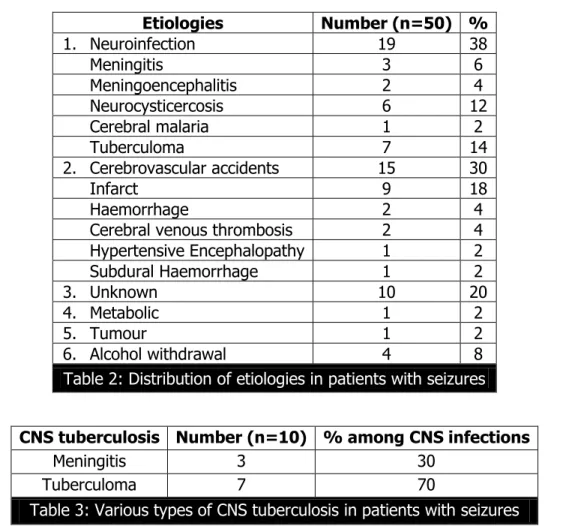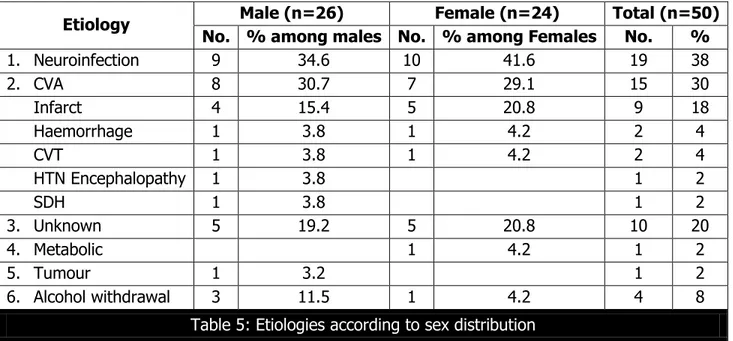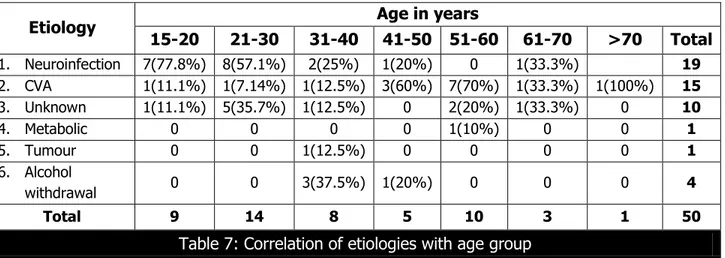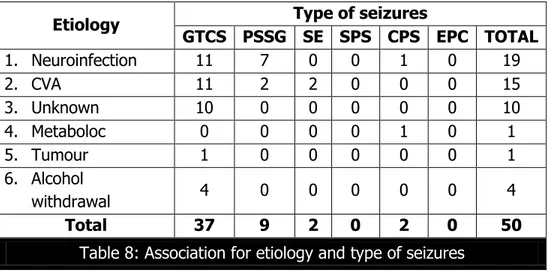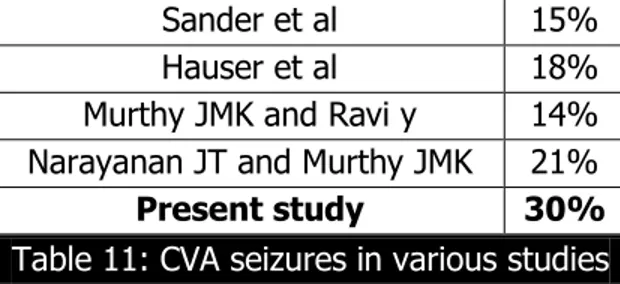J of Evidence Based Med & Hlthcare, pISSN- 2349-2562, eISSN- 2349-2570/ Vol. 2/Issue 41/Oct. 12, 2015 Page 7032
ETIOLOGICAL PROFILE OF NEW ONSET SEIZURES
S. M. Saifullah Quraishi1, P. S. Usha Rani2, P. Prasanthi3, P. Sudhakar4
HOW TO CITE THIS ARTICLE:
S. M. Saifullah Quraishi, P. S. Usha Rani, P. Prasanthi, P. Sudhakar. “Etiological Profile of New Onset Seizures”. Journal of Evidence based Medicine and Healthcare; Volume 2, Issue 41, October 12, 2015; Page: 7032-7044, DOI: 10.18410/jebmh/2015/960
ABSTRACT: Seizures are common disorders found all over the world and are encountered frequently during medical practice in variety of settings. Presently CNS infections like malaria, meningitis, tuberculosis, HIV, Neurocysticercosis account for significant number of cases in developing countries. Since these infections vary from region to region; etiology of seizure may also vary from region to region. Etiological spectrum of acute symptomatic seizures in developing countries is different from developed countries. So this study was done to know the various etiologies of new onset seizures in adults in this region. Sample size taken for the study is 50 patients with new onset seizures. It is concluded that etiological spectrum of seizures was varied and included Neuroinfection, CVA, idiopathic, alcohol withdrawal, Tumor, Metabolic. Tuberculoma and neurocysticercosis are most common cause of seizure among Neuroinfection.
INTRODUCTION: Seizures are common disorders found all over the world and are encountered frequently during medical practice in variety of settings.
Etiological spectrum of acute symptomatic seizures in developing countries is different from developed countries. Presently CNS infections like malaria, meningitis, tuberculosis, HIV, neurocysticercosis account for significant number of cases in developing countries.[1] Since these
infections vary from region to region; etiology of seizure may also vary from region to region. In Indian subcontinent cerebral venous thrombosis is common in postpartum women presents with severe headache, low-grade fever and seizures.[2] Seizures occur in about 40
percent of the patients, which is higher when compared to arterial stroke. Focal seizures are more common but they can generalize to a life-threatening status epilepticus.[3]
Etiology of seizures can be easily made out in most of the older patients. The causes
include subdural hematoma, stroke, CNS infections, degenerative disorders like Alzheimer’s
disease and malignancy which includes malignant gliomas, and brain metastases [4]. In stroke
seizures occur more commonly with hemorrhagic stroke than with ischemic stroke. They also can occur with systemic metabolic conditions like uremia, hyperglycemia, hypoglycemia, hyponatremia and alcohol withdrawal.
So this study is done to know the various etiologies of new onset seizures in adults in this region. With the advent of modern technologies like CT scan, MRI and CSF serology for infection like viral, tubercular, neurocysticercosis, the diagnosis of seizure has become more accurate and has completely changed the course of management.
AIMS AND OBJECTIVES OF THE STUDY:
J of Evidence Based Med & Hlthcare, pISSN- 2349-2562, eISSN- 2349-2570/ Vol. 2/Issue 41/Oct. 12, 2015 Page 7033 Sample size taken for the study is 50.
As etiology of seizures vary from region to region, this study is done to know etiological spectrum of seizures in a region of Kurnool and the surrounding places.
MATERIALS AND METHODS:
Source of Data: 50 patients admitted with new onset seizures from the Government General Hospital, Kurnool Medical College, Kurnool who filled the inclusion and exclusion criteria as mentioned below.
Study began on October 2012 and ended on July 2014.
Methods of Collection of Data: Patients presenting with history of seizures were included in the study. Patient and eyewitness were interviewed regarding history, and clinical examination was done.
The investigations included hemoglobin level total count, differential count, ESR, urine routine, blood urea, serum creatinine, blood glucose levels, liver function tests and estimation of serum electrolytes like sodium, potassium, and calcium.
Special investigations like lumbar puncture, serological tests, CT scan brain, ECG were done in selected cases.
Inclusion Criteria:
1. Age of patients more than or equal to 15 years. 2. Patients presenting with new onset seizures.
New onset seizures is defined as the first seizure (or the first cluster of seizures with in 24 hour period) ever experienced by the patient.
Exclusion Criteria: Patient with seizure like episodes.
Hyperventilation.
TIA.
Narcolepsy.
Movement disorder like choreathetosis, tic disorder.
Psychogenic seizures.
OBSERVATION AND RESULTS: The results of the study are shown in tables as below. The base line characteristics observed are as follows.
Number of cases -50.
Age in years
Male Female Combined
No % among
males No
% among
Females No %
< 20 4 15.4 5 20.8 9 18
J of Evidence Based Med & Hlthcare, pISSN- 2349-2562, eISSN- 2349-2570/ Vol. 2/Issue 41/Oct. 12, 2015 Page 7034
31-40 6 23.1 2 8.3 8 16
41-50 3 11.5 2 8.3 5 10
51-60 4 15.4 6 25 10 20
61-70 1 3.8 2 8.3 3 6
> 70 0 0 1 4.2 1 2
Total 26 100 24 100 50 100
Mean+SD 39.9+19.17 37.0+14.21 38.44+16.6
Table 1: Age and sex distribution
In the present study patient’s age ranged from 15 years to 75 years with Mean age of 38.44 years.
Majority of patients were in the age group of 21-30 years (n=14, 28%) followed by 51-60 years (n=10, 20%).
92% of the patients were in the 2nd-5th decade. 8% of the patients were in the age group of
>60 years.
Out 50 patients 26 were male patients 24 were female patients with male to female ratio of 1.08:1.
Majority of males and females were in 3rd decade.
Etiologies Number (n=50) %
1. Neuroinfection 19 38
Meningitis 3 6
Meningoencephalitis 2 4
Neurocysticercosis 6 12
Cerebral malaria 1 2
Tuberculoma 7 14
2. Cerebrovascular accidents 15 30
Infarct 9 18
Haemorrhage 2 4
Cerebral venous thrombosis 2 4
Hypertensive Encephalopathy 1 2
Subdural Haemorrhage 1 2
3. Unknown 10 20
4. Metabolic 1 2
5. Tumour 1 2
6. Alcohol withdrawal 4 8
Table 2: Distribution of etiologies in patients with seizures
CNS tuberculosis Number (n=10) % among CNS infections
Meningitis 3 30
Tuberculoma 7 70
J of Evidence Based Med & Hlthcare, pISSN- 2349-2562, eISSN- 2349-2570/ Vol. 2/Issue 41/Oct. 12, 2015 Page 7035
Meningitis Number (n=5) % among meningitis
Tuberculosis 3 60
Viral 2 40
Table 4: Various types of Meningitis in patients with seizures
Meningitis accounted for 10% (n=5) of seizures of which Tubercular meningitis is the most common meningitis (n=3, 60%), followed by viral 40% (2).
Etiology Male (n=26) Female (n=24) Total (n=50) No. % among males No. % among Females No. %
1. Neuroinfection 9 34.6 10 41.6 19 38
2. CVA 8 30.7 7 29.1 15 30
Infarct 4 15.4 5 20.8 9 18
Haemorrhage 1 3.8 1 4.2 2 4
CVT 1 3.8 1 4.2 2 4
HTN Encephalopathy 1 3.8 1 2
SDH 1 3.8 1 2
3. Unknown 5 19.2 5 20.8 10 20
4. Metabolic 1 4.2 1 2
5. Tumour 1 3.2 1 2
6. Alcohol withdrawal 3 11.5 1 4.2 4 8
Table 5: Etiologies according to sex distribution
CVT- Cerebral Venous Thrombosis, CVA – Cerebrovascular Accident, SDH- subdural haemorrhage
Table 6: Etiologies according to sex distribution. In males (n=26)
Majority of seizures were because of Neuroinfection 34.6% (9), followed by CVA 30.7% (8), unknown 19.2% (5), and Alcohol withdrawal 11.5% (3).
Neuroinfection seizures accounted for 34.6% of seizures in males.
CVA seizures accounted for 30.37% of seizures in males.
Unknown seizures accounted for 19.2% of seizures in males.
75% of seizures due to Alcohol withdrawal occurred in males.
Among CVA (n=8).
Majority of seizures were because of Infarct 50% (N=4), followed by hemorrhage (12.5%), CVT (12.5%, SDH (12.5%).
J of Evidence Based Med & Hlthcare, pISSN- 2349-2562, eISSN- 2349-2570/ Vol. 2/Issue 41/Oct. 12, 2015 Page 7036
In females (n=4).
A majority of seizures were because of Neuroinfection 41.6% (10), followed by CVA 29.1% (7), unknown (5) 20.8%,
41.6% of the seizures due to Neuroinfections occurred in females.
29.1% of the seizures due to CVA occurred in females.
Among CVA (n=7)
Majority of seizures were because of infarct (71.4%) followed by Haemorrhage (14.2%), CVT (14.2%).
CVT commonly occurred post-partum females causing seizures.
2% of seizures occurred due to metabolic causes.
Etiology Age in years
15-20 21-30 31-40 41-50 51-60 61-70 >70 Total
1. Neuroinfection 7(77.8%) 8(57.1%) 2(25%) 1(20%) 0 1(33.3%) 19
2. CVA 1(11.1%) 1(7.14%) 1(12.5%) 3(60%) 7(70%) 1(33.3%) 1(100%) 15
3. Unknown 1(11.1%) 5(35.7%) 1(12.5%) 0 2(20%) 1(33.3%) 0 10
4. Metabolic 0 0 0 0 1(10%) 0 0 1
5. Tumour 0 0 1(12.5%) 0 0 0 0 1
6. Alcohol
withdrawal 0 0 3(37.5%) 1(20%) 0 0 0 4
Total 9 14 8 5 10 3 1 50
Table 7: Correlation of etiologies with age group
1. 15-20 years (n=9): Most common etiology is Neuroinfection 77.8% (7), followed by CVA 11% (1).
2. 21-30 years (n=14): Most common etiology is Neuroinfection 57.1% (8), followed by unknown seizures (5)35.7%.
3. 31-40 years (n=8): Most common etiology is Alcohol withdrawal 37.5% (3), followed by Neuroinfection 2(25%).
4. 41-50 years (n=5): Most common etiology is CVA 60% (3), followed by Neuroinfetion 20% (1) and alcohol withdrawal 20% (1).
5. 51-60 years (n=10): Most common etiology is CVA 70% (7) followed by unknown (2) 20% 6. 61-70 years (n=3): Most common etiologies are neuroinfection (33.3%), CVA (33.3%),
unknown (33.3%).
7. >70 years (n=1): All were because of CVA (100%).
78.9% of Neuroinfection were seen in 2nd and 3rd decade. 66.6% of CVA occurred in 5th & 6th decade.
50% of unknown seizures occurred in 3rd decade
J of Evidence Based Med & Hlthcare, pISSN- 2349-2562, eISSN- 2349-2570/ Vol. 2/Issue 41/Oct. 12, 2015 Page 7037
Etiology Type of seizures
GTCS PSSG SE SPS CPS EPC TOTAL
1. Neuroinfection 11 7 0 0 1 0 19
2. CVA 11 2 2 0 0 0 15
3. Unknown 10 0 0 0 0 0 10
4. Metaboloc 0 0 0 0 1 0 1
5. Tumour 1 0 0 0 0 0 1
6. Alcohol
withdrawal 4 0 0 0 0 0 4
Total 37 9 2 0 2 0 50
Table 8: Association for etiology and type of seizures
GTCS: Generalized tonic- Clonic Seizure, PSSG – Partial Seizure with Secondary Generalization. SE: Status Epilepticus, SPS-Simple Partial Seizure, CPC-Complex Partial Seizures, EPC- Epilepsia Partialis Continua.
GTCS (n=37) is the most common seizure. The most common cause for GTCS is Neuroinfection (29.7%) and CVA (29.7%) followed by Unknown (27%).
77.7% of PSSG is caused by Neuroinfection.
22.2% of PSSG is caused by CVA.
4% of seizures were CPS caused by Neuroinfections and Metabolic causes.
Most of Neuroinfection patients presented with GTCS 57.3%, followed by PSSG 36.8%.
86.6% of CVA patients presented with GTCS followed by PSSG (13.3%).
10.8% of GTCS were caused by alcohol withdrawal.
100% of unknown seizures were GTCS.
DISCUSSION: Presently CNS infections like Malaria, Meningitis, Tuberculosis, HIV, Neurocysticerosis account for significant number of cases in developing countries. Since these infections vary from region to region; etiology of seizure may also vary from region to region. In Indian subcontinent cerebral venous thrombosis is common in post-partum women presents with severe headache, low-grade fever and seizures. Single small enhancing CT lesions are frequently reported from India. Etiological spectrum of seizures in developing countries is different from developed countries.[2]
So this study on “seizures” was done to know the various etiologies of new onset seizures
in adults in this region.
The present study “Etiological study of new onset seizures” was carried out in Govt. General Hospital attached to Kurnool Medical College, Kurnool.
J of Evidence Based Med & Hlthcare, pISSN- 2349-2562, eISSN- 2349-2570/ Vol. 2/Issue 41/Oct. 12, 2015 Page 7038
AGE AND SEX DISTRIBUTION: Etiological spectrum depends on age, sex, geography and medical setting
Out of 50 patients 26 were males and 24 females, with male to female ratio of 1.08:1. Majority of males were in 3rd and 4th decade and females were in 3rd and 6th decade.
In our study majority of patients were younger unlike western studies where many were in older age group.
No difference in male to female ratio was observed. All studies were slightly male predominate.
Sander5 et al (11900) Sinha et al6 Present study
Acute symptomatic seizures 15% 57.8 70%
Unknown seizures 62% 23.4 20%
Remote symptomatic seizure 21% 18.8 10%
Table 9: Etiological Spectrum of Seizures
Acute symptomatic seizures accounts for 70% of seizures in the present study, which is comparable to the Indian study by sinha et al.[6] Acute symptomatic seizures occur at the time of
a systemic insult or in close temporal association with a documented brain insult. Seizures are considered to be acute symptomatic if they occur in the first 7 days of cerebrovascular insults, traumatic brain injury, CNS infections or provoked by acute medical illness.
Unknown seizures were most common seizures in western population unlike acute symptomatic in present study. In the present study, the cause for seizures could not be found in 20% of cases.
Remote symptomatic seizures in the present study accounted for 10%. Prior cerebrovascular disease is the most commonly identified remote precipitant for new seizures. Stroke lead to a 9% cumulative probability over 10 years of developing seizures, with the greatest risk in the first year. Cortical involvement and early seizures after the stroke increase the risk of late seizures and epilepsy. In those 35-64 years of age old cerebrovascular events are the most common remote injury identified, followed by old trauma and known tumors. The risk of late seizures from previous CNS infection depends on the type of infection and its remoteness. Aseptic meningitis does not increase the risk. Bacterial meningitis carries a risk for late seizures that is five times that of the risk for the general population, but possibly just for the first 5 years. Viral encephalitis is associated with a risk 10 times that of the general population, lasting at least 15 years after the insult.[7]
Table 10: Etiologies observed in various studies.
Vascular 15%
Tumour 6%
Infection 2%
Alcohol related 9%
J of Evidence Based Med & Hlthcare, pISSN- 2349-2562, eISSN- 2349-2570/ Vol. 2/Issue 41/Oct. 12, 2015 Page 7039
Cerebrovascular disease 15%
CNS infection 15%
Traumtic brain injury 13%
Tumor 13%
Alcohol withdrawal 11%
Metabolic 10%
Hauser8 et al (1995) U.S.A
Neuroinfection is leading cause of seizure which accounted for 38%, followed by cerebrovascular accidents 30%, and idiopathic 20%. In 8% of patients cause is alcohol withdrawal. In Neuroinfection, Tuberculoma accounted for 14% of seizures followed by Neurocysticercosis 12%, meningitis 6%, meningoencephalitis 4%, and cerebral malaria 2%. Stroke accounted for 22% (infarct-18%, haemorrhage-2%), followed by unknown causes 20% and alcohol withdrawal 8%.
Neuroinfection Seizures: Neuroinfection occurred in 2% of the patients in Sander et al study,[5] 15% in Hauseret al,[8] 77% in study by Murthy JMK and Ravi Y[1] and 32% in study by
Narayanan JT and Murthy JMK[9] In our study etiology is comparable to Indian studies.
In the present study Neuroinfection is the leading cause for seizures which is different from the international studies, but comparable to Indian studies. Among Neuroinfection, Tuberculoma and Neurocysticercosis accounted for 68.4%. tuberculosis, through rare in the developed countries, associated with high frequency of neurological manifestations in the developing countries like India in the form of tuberculoma and TB Meningitis. As the present study is done in the Endemic Area for Tuberculosis, CNS Tuberculosis accounted for 20% of seizures which is high when compared to other studies.
Tuberculous meningitis is the most common type of chronic meningitis in India. In tuberculous meningitis seizures can occur at any stage of the illness and may be the presenting feature. More than 60% of patients with intracranial tuberculoma may have seizures. In one study 50% of the patient with CNS tuberculosis had seizures.[10] The central nervous system
(CNS) involvement comprises approximately 10-15% of all tuberculous infections.
Neurocysticercosis is the most common parasitic disease of the nervous system and is the main cause of acquired epilepsy in the developing countries. It has also been a problem in industrialized countries because of the immigration of tape worm carries from areas of endemic disease. Solitary Cerebral Cysticercus Granuloma (SCCG) the common cause of seizures in Indian patients. It presents with partial seizures in 26% to 50% of patients.
J of Evidence Based Med & Hlthcare, pISSN- 2349-2562, eISSN- 2349-2570/ Vol. 2/Issue 41/Oct. 12, 2015 Page 7040
CVA Seizures: CVA occurred in 15% of the patients in Sander et al study, 18% in HAUSER et al, 14% in the study by Murthy JMK and Ravi and 21% in study by Narayanan JT and Murthy JMK. In our study CVA occurred in 30%.
Sander et al 15%
Hauser et al 18%
Murthy JMK and Ravi y 14%
Narayanan JT and Murthy JMK 21%
Present study 30%
Table 11: CVA seizures in various studies
CVA is the second most common cause seizures in the present study. Among the CVA, Infarct accounted for 56.2% followed by hemorrhage accounted for 10.5%. CVT 10.5%, SDH and HTN Encephalopathy accounting for 5.3% each.
CVA can cause acute symptomatic and remote symptomatic seizures. In the present study CVA resulted in 66.6% of acute symptomatic seizures and 33.3% of remote symptomatic seizures.
In older adults, acute stroke is the most common cause accounting for up to one-half of cases.[11] Seizures occur in 4 to 9 percent of acute cerebrovascular events; all stroke types
including TIAs, are associated with seizure.[12] Risk factors for acute seizures (as those occurring
within 2 to 4 weeks after the event) include hemorrhage of large size, and cortical involvement.[13]
There is increased incidence of infarct related seizures in the present study because of increased risk factors in the population such as smoking, diabetes mellitus, alcohol consumption, hyperlipidemia which are major contributors for the development of thromboembolic stroke.
Unknown Seizures: Those epilepsies, which are termed cryptogenic, will now be referred to as being of unknown cause. Cryptogenic seizures were defined in 1989 as presumed symptomatic in which the cause has not been identified. Unknown is meant to be viewed neutrally and to designate that the nature of the underlying cause is yet unknown; it may have a fundamental genetic defect at its core or it may be the consequence of a separate as yet unrecognized disorder.[14]
In the present study unknown seizures accounted for 20% comparable to other studies. In a population based study of newly diagnosed epilepsy done in Chalfont Centre for epilepsy, UK by Manford M, unknown seizures accounted for 24.6% in study by SANDER et al unknown seizures accounted for 62%.
Manford M, Hart Y M 24.6%
Sander et al 62%
Present study 20%
J of Evidence Based Med & Hlthcare, pISSN- 2349-2562, eISSN- 2349-2570/ Vol. 2/Issue 41/Oct. 12, 2015 Page 7041
Alcohol Withdrawal Seizures: Alcohol related seizures occurred in 9% of the patients in SANDER et al study,[5] 11% in HAUSER et al,[8] and 8% in our study. Alcohol related seizures
were not less common when compared with western studies.
Alcohol withdrawal seizures usually occur in 4th and 5th decades of life, after many years of
alcohol abuse, often in binge drinkers. Seizures are usually generalized convulsions, occurring abruptly without warning 6-48 hours after cessation of alcohol use, often in clusters, and rarely exceeding 5 in 6 hours. As much as one-fourth of such withdrawal seizures may have focal onset.[6] Alcohol abuse is a major precipitant of status epileptics, which may even be the first ever
seizure type, seizure risk is strongly dose dependent.[15]
In the present study alcohol withdrawal seizures accounted for 8% comparable to other studies as increased prevalence of alcohol abuse in the population.
Tumours: In the present study, tumours accounted for only 2%. Tumours accounted for 6% in Sander et al study, 13% in HAUSER et al study, 7% in MURTHY JMK and RAVI Y study. There is decreased incidence of tumours in causing seizures in the present study when compared to other studies
A seizure is the presenting symptom in 33% of the patients who have gliomas and 15-20% of the patients who have brain metastasis and seizures at some point in 40-60% of the patients who have gliomas and 30-40% of the patients who have brain metastasis. Approximately 30% of the patients who have brain tumors have seizures as the initial symptom. Slow-growing tumors, such as oligodendrogliomas and low-grade astrocytomas, commonly present with seizures whereas aggressive tumors, such as glioblastomas, more often present with symptoms mass effect.[16]
Metabolic Seizures: Metabolic abnormalities account for 9% of acutely triggered seizures.[8] In
the present study metabolic seizures accounted for 2% of seizures.
Patients with renal failure have seizures related to several syndromes. Dialysis disequilibrium occurs during or shortly after dialysis, especially with rapid correction of severe uremia, possibly related to brain edema caused by the rapid osmotic changes. Uremic encephalopathy is also frequently associated with seizures. They are usually generalized tonic-clonic seizures, although focal motor seizures as well as epilepsia partialis continua can occur.
Hauser et al 10%
Murthy JMK and Ravi Y 3% Narayanan JT and Murthy JMK 32%
PRESENT STUDY 2%
Table 13
Etiological spectrum of seizures in different age group:
78% of Neuroinfection were seen in 2nd and 3rd decade. 66% of CVA occurred in 5th and 6th decade.
50% idiopathic seizures occurred 3rd decade.
J of Evidence Based Med & Hlthcare, pISSN- 2349-2562, eISSN- 2349-2570/ Vol. 2/Issue 41/Oct. 12, 2015 Page 7042
Seizures due to CVA occurred in 13.3% of patient in age group 15-25 years because all the Cerebrovascular accidents were because of cerebral venous thrombosis due to postpartum status in females and thrombophilic states in males.
Cerebral venous thrombosis is more common in women than men, with a female to male ratio of 3:1.[17] This imbalance may be due to the increased risk of CVT associated with
pregnancy and puerperium and with oral contraceptives.[18]
Association of Etiology and Type of Seizures:
Most of Neuroinfection patients presented with GTCS (57.9%) and PSSG (36.8%).
73.3% of CVA patients presented with GTCS followed by PSSG (13.3%) and SE (13.3%).
100% of idiopathic seizures were GTCS.
100% alcohol withdrawal seizures were GTCS.
GTCS is most common in the present study, that may be because the history of seizures given by the bystanders. A partial seizures with secondary generalization is often difficult to distinguish from a primarily generalized tonic-clonic seizure, since bystanders tend to emphasize the more dramatic, generalized convulsive phase of the seizure and overlook the more subtle, focal symptoms present at onset.
CONCLUSION: From the present study “Etiological profile of new onset seizures in adults” done in 50 cases, the following conclusions were made.
In 50 patients of new onset seizures the male to female ratio is 1.08:1, with slight male preponderance.
70% of seizures were acute symptomatic seizures, 10% are remote symptomatic seizures in which underlying etiologies can be made and 20% seizures are unknown in which the cause could not be identified.
Majority of seizures occurred in patients <60 years.
Etiological spectrum of seizures was varied and included Neuroinfection, CVA, idiopathic, alcohol withdrawal, Tumor, Metabolic.
Neuroinfection is the commonest cause of seizures followed by cerebrovascular accidents accounted for significant number of seizures in all the age groups
Tuberculoma and neurocysticercosis are most common cause of seizure among Neuroinfection
GTCS is most common type of seizure accounted.
The results of the present study are comparable to Indian studies in which neuro infection is the predominant cause of seizures, whereas in western studies cerebrovascular causes accounted for major cause of seizures.
REFERENCES:
1. Murthy JMK, Yangala R, Acute symptomatic seizures – incidence and etiological spectrum: a hospital based study from South India. Seizure 1999; 8: 162-165.
J of Evidence Based Med & Hlthcare, pISSN- 2349-2562, eISSN- 2349-2570/ Vol. 2/Issue 41/Oct. 12, 2015 Page 7043
4. Lourdes V, Linda M.Seizure Disorders in Elderly, Am Fam Physician 2003; 67: 325-332. 5. Sander JWAS, Hart YM, Johnson AL, Shorvon SD, National General Practice study of
Epilepsy: newly diagnosed epileptic seizures in a general population Lancet 1990; 336: 1267-1271.
6. Sinha S.Satish Chandra P, Kalband BR, ThennarasuK, New-onset status epilepticus and cluster seizures in the elderly, J Cin Neurosci 2013; 20: 423-8.
7. Heidi LR, Frank WD, Seizures, Neurol Clin 1998; 16(2): 257-284.
8. Annegers JF, Hauser WA, Lee JRJ, Rocca W, Incidence of acute symptomatic seizures in Rochester, Minnesota, 1935-1984, Epilepsia 1995; 36: 327-333.
9. Narayanan JT, Murthy J. New-onset acute symptomatic seizure in a neurological intensive care unit. Neurol India 2007; 55: 136-140.
10.Bayindir C, Mete O, Bilgic B. Retrospective study of 23 pathologically proven cases of central nervous system tuberculomas. Clin Neurol Neurosurg 2006; 108(4): 353-357.
11.Laccheo I, Ablahe E, Heinrich R, et al, Assessment of quality of time among the elderly with epilepsy. Epilepsy behave 2008; 12: 257.
12.Bladin CF, Alexandrov AV, Bellavance A et al, Seizures after stroke: prospective multi centre study, Arch Neurol 2000: 57: 1617.
13.Lancman ME, GolimstokA, Norscini J, Granillo R, Risk factors for developing seizures after a stroke. Epilepsia 1993; 34: 141.
14.Anne T, Berg, Samuel F Berkovic. Revised terminology and concepts for organization of seizures and epilepsies: Report of the ILAE commission on classification and terminology, 2005-2009. Epilepsia volume 51, Issue 4, Pages 676-685- April 2010.
15.Hillbom M, Pieninkeroinen I, Leone M. Seizures in alcohol-dependent patients: epidemiology, Pathophysiology and management CNS Drugs 2003; 17 (14): 1013-30.
16.Daviu S, Tracy B.wen Y.Neurologic Emergencies in Cancer patients. Neurol clin 1998; 16(2): 449-484.
17.Coutinho JM, Ferro JM, Canhao, P, et al, Cerebral venous and sinus thrombosis in women. Stroke 2009; 40: 2356.
J of Evidence Based Med & Hlthcare, pISSN- 2349-2562, eISSN- 2349-2570/ Vol. 2/Issue 41/Oct. 12, 2015 Page 7044
4. Professor & HOD, Department of General Medicine, Kurnool Medical College.
NAME ADDRESS EMAIL ID OF THE CORRESPONDING AUTHOR: Dr. S. M. Saifullah Quraishi, 50/761/3, Devanagar, Kurnool-518001.
E-mail: safu53@yahoo.co.in
Date of Submission: 01/10/2015.
Date of Peer Review: 03/10/2015. Date of Acceptance: 05/10/2015. Date of Publishing: 09/10/2015.
AUTHORS:
1. S. M. Saifullah Quraishi 2. P. S. Usha Rani
3. P. Prasanthi 4. P. Sudhakar
PARTICULARS OF CONTRIBUTORS: 1. Assistant Professor, Department of
General Medicine, Kurnool Medical College.
2. Assistant Professor, Department of General Medicine, Kurnool Medical College.
